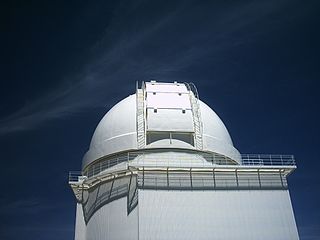
The Calar Alto Observatory is an astronomical observatory located in Almería province in Spain on Calar Alto, a 2,168-meter-high (7,113 ft) mountain in the Sierra de Los Filabres range.

X Sagittarii is a variable star and candidate binary star system in the southern constellation of Sagittarius, near the western constellation boundary with Ophiuchus. It has a yellow-white hue and is visible to the naked eye with an apparent visual magnitude that fluctuates around 4.54. The star is located at a distance of approximately 950 light years from the Sun based on parallax, and is drifting closer with a radial velocity of −10 km/s. The star has an absolute magnitude of around −2.85.

NGC 2997 is a face-on unbarred spiral galaxy about 40 million light-years away in the faint southern constellation of Antlia. It was discovered March 4, 1793 by German-born astronomer William Herschel. J. L. E. Dreyer described it as, "a remarkable object, very faint, very large, very gradually then very suddenly bright middle and 4 arcsec nucleus. This is the brightest galaxy of the NGC 2997 group of galaxies, and was featured on the cover of the first edition of Galactic Dynamics by James Binney and Scott Tremaine.
HD 8574 is a single star in the equatorial constellation of Pisces. It can be viewed with binoculars or a telescope, but not with the naked eye having a low apparent visual magnitude of +7.12. The distance to this object is 146 light years based on parallax, and it has an absolute magnitude of 3.88. The star is drifting further away from the Sun with a radial velocity of +18 km/s. It has a relatively high proper motion, advancing across the celestial sphere at the rate of 0.298 arc seconds per annum.

19 Cephei is a supergiant star in the northern circumpolar constellation of Cepheus. It has a spectral class of O9 and is a member of Cep OB2, an OB association of massive stars located about 615 parsecs (2,010 ly) from the Sun.

54 Ceti is an older Flamsteed designation for a star that is now located within the constellation boundaries of Aries, the Ram. In the present day it is known by star catalogue identifiers like HD 11257 or HR 534. At an apparent visual magnitude of 5.94, it can be seen with the naked eye. The distance to this star, as determined using parallax measurements made during the Hipparcos mission, is approximately 139 light-years, give or take a 6 light-year margin of error. It is located near the ecliptic and hence is subject to occasional occultation by the Moon.
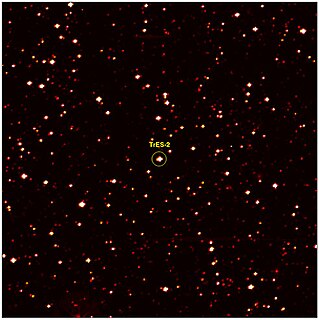
GSC 03549-02811, also known as Kepler-1) is a yellow main-sequence star similar to our Sun. This star is located approximately 704 light-years away in the constellation of Draco. The apparent magnitude of this star is 11.41, which means it is not visible to the naked eye but can be seen with a medium-sized amateur telescope on a clear dark night. The age of this star is about 5 billion years.
An integral field spectrograph, or a spectrograph equipped with an integral field unit (IFU), is an optical instrument combining spectrographic and imaging capabilities, used to obtain spatially resolved spectra in astronomy and other fields of research such as bio-medical science and earth observation.

HD 211575 is a star in the constellation Aquarius in between "Gamma Aquarii", "Pi Aquarii" and "Sadalmelik". It is a member of the corona of the Ursa Major moving group.

NGC 2397 is a flocculent spiral galaxy located in the southern Volans constellation, about one degree to the SSE of Delta Volantis. English astronomer John Herschel discovered the galaxy on February 21, 1835. It is located at a distance of approximately 69 million light years from the Sun, and is a member of the small NGC 2442 group that includes NGC 2434.

Gamma Crateris is a binary star system, divisible with a small amateur telescope, and located at the center of the southern constellation of Crater. It is visible to the naked eye with an apparent visual magnitude of 4.06. With an annual parallax shift of 39.62 mas as seen from Earth, this star is located 82.3 light years from the Sun. Based upon the motion of this system through space, it is a potential member of the Castor Moving Group.

Rho Cygni, Latinized from ρ Cygni, is a yellow-hued star in the northern constellation of Cygnus. It is visible to the naked eye with an apparent magnitude of 4.02. The measured annual parallax shift is 26.39 milliarcseconds, which yields a distance estimate of 124 light years. It is moving further from the Sun with a radial velocity of +6.88. The star is a member of the thin disk population of the Milky Way galaxy.
90 Tauri is a star in the zodiac constellation of Taurus, located 144 light years away from the Sun. It is visible to the naked eye as a faint, white-hued star with an apparent visual magnitude of 4.27. 90 Tauri is a member of the Hyades cluster and is listed as a double star.
WASP-56 is a sun-like star of spectral type G6 in the constellation of Coma Berenices. It has an apparent magnitude of 11.48. Observations at the Calar Alto Observatory using the lucky imaging technique detected a candidate companion star located 3.4 arc seconds away, however it is not known if this is an actual binary companion or an optical double.
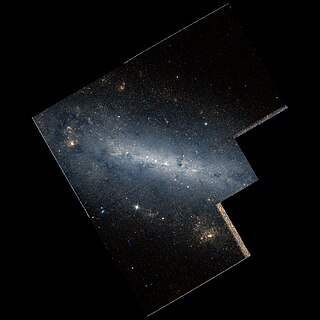
NGC 672 is a spiral galaxy in the northern constellation of Triangulum, positioned around 2° to the southwest of the star Alpha Trianguli. The original object designated NGC 672 was discovered by the German-born astronomer William Herschel on 26 October 1786, but this was later cataloged as NGC 614. The object now identified as NGC 672 was discovered by John Herschel on 11 November 1827.
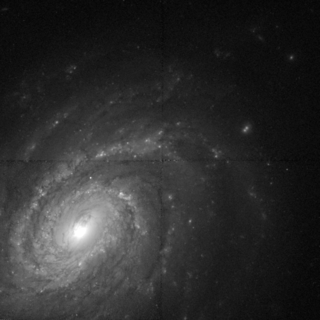
NGC 214 is a spiral galaxy in the northern constellation of Andromeda, located at a distance of 194 megalight-years from the Milky Way. It was discovered on September 10, 1784 by William Herschel. The shape of this galaxy is given by its morphological classification of SABbc, which indicates a weak bar-like structure (SAB) at the core and moderate to loosely-wound spiral arms (bc).

NGC 810 is an unbarred elliptical galaxy located in the constellation Cetus, approximately 360 million light-years from the Milky Way. It was discovered by the French astronomer Édouard Stephan in 1871.
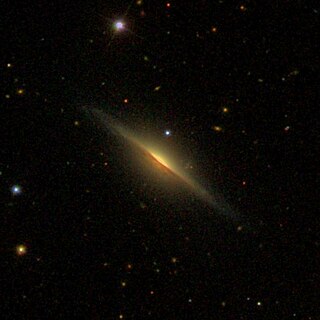
NGC 825 is an unbarred spiral galaxy in the constellation Cetus, estimated to be 154 million light-years away. The object was discovered by the astronomer Albert Marth on November 18, 1863.

NGC 5966 is an elliptical galaxy in the constellation Boötes. NGC 5966 is its New General Catalogue designation. The galaxy was discovered by William Herschel on March 18, 1787. Based on its redshift, it is located about 220 million light-years away from the Sun.
WASP-58 is a binary star system comprising a G-type main-sequence star and a red dwarf about 955 light-years away. WASP-58 is slightly depleted in heavy elements, having 80% of the solar abundance of iron. WASP-58 is much older than the Sun at 12.80+0.20
−2.10 billion years.















